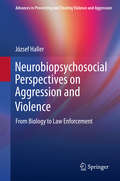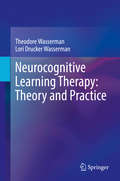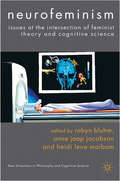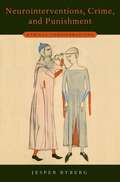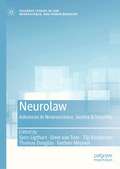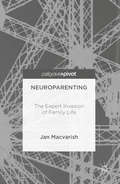- Table View
- List View
Neural Networks: An Introductory Guide for Social Scientists (PDF)
by Professor G David GarsonThis book provides the first accessible introduction to neural network analysis as a methodological strategy for social scientists. The author details numerous studies and examples which illustrate the advantages of neural network analysis over other quantitative and modelling methods in widespread use. Methods are presented in an accessible style for readers who do not have a background in computer science. The book provides a history of neural network methods, a substantial review of the literature, detailed applications, coverage of the most common alternative models and examples of two leading software packages for neural network analysis.
Neural Stem Cells: Methods and Protocols (Methods in Molecular Biology #438)
by Leslie P. WeinerMany questions related to stem cell properties and neural stem cell lineage and differentiation still linger. This second edition revises and expands upon the successful first edition in order to provide the most current, cutting-edge methods of today for the scientists working to answer these questions. The use of these step-by-step, readily reproducible laboratory protocols will allow investigators to produce pure populations that can serve as a means of understanding the biology of neural stem cells and adapting them for transplantation into disease models. This is an excellent source of information and inspiration.
Neural Tissue Transplantation Research (Proceedings in Life Sciences)
by R. B. Wallace G. D. DasDuring the last decade research on neural transplantation in mammals has grown extensively, and has attracted the attention of many young inquisitive scientists. This growth, as the critics point out, has been somewhat random, and has resulted neither in the formulation of basic concepts nor in any other significant achievement. For instance, they question-how is it possible to jump into functional research with clinical bearing when the basic morphological work has not yet been conducted? The criticism, objectively speaking, is valid and is supported by the fact that every investigator who has stepped into this unex plored field of neurosciences has formulated questions in his own way, has followed his own "model" oftransplantation, and has arrived at his own unique conclusions. The potential danger, as the critics emphasize, in this type of approach lies in that instead of evolving into a scientifically solid and valuable field of research, it may end in a confusing and conflicting mass of questionable claims and subjective opinions. The present situation, very likely, is a reflection of unrestrained enthusiasm and imaginativeness of the investigators, and the demands of the times for the so-called "newsworthy" and "breakthrough" publications. Despite these limitations, two important facts have been estab lished in this field. First, as far as transplantation of neural tissues per se is concerned, what was considered impossible by some critics about 10-12 years ago has been shown to be possible.
Neuro-Futurism and Re-Imagining Leadership: An A-Z Towards Collective Liberation (Studies in Mobilities, Literature, and Culture)
by Kai Syng TanThis book is a rip-roaring manifesto that re-claims ways to think about and do ‘leadership’. Colliding mobilities, neuro-queering, the arts and culture, critical leadership studies, social justice, creative pedagogy, futurity and Daoist cosmology for the first time, the book proposes ‘neuro-futurism’ as a beyond-colonial, heuristic change-making tool-kit for individuals and institutions. Celebrating the Dangerous, Demeaning and Dirty labour of Deviant/Defiant culture-workers often side-lined in (leadership) scholarship across 26 break-neck chapters and 39 images, this book challenges white-supremacist-cis-het-neuro-normative-capitalist-patriarchal forms of power and knowledge. Punchy, punching up and pulling no punches, it is a call to arms, feet, sole-soul, to co-create tables/houses/worlds that profit (neuro-)divergent people, planet, poetry and play. The deadline is 2050, so we’re running out of time. Are you ready for an extra-ordinary adventure?
Neurobiologische Aspekte der Bildungsprozesse im Kleinkindalter: Umsetzung wissenschaftlicher Erkenntnisse in Kinderkrippen
by Katrin WalbachIn der Diskussion über den Ausbau von Tageseinrichtungen für Kinder unter drei Jahren steht meist die Versorgung berufstätiger Eltern mit Plätzen für ihre Kinder im Fokus, während die Krippe als Gestaltungsort frühkindlicher Erziehung in den Hintergrund gerät. Anhand drei empirischer Fallanalysen untersucht Katrin Walbach die Ausgestaltung von Bildungsprozessen in Kinderkrippen und zeigt die Unterschiede in der Anwendung wissenschaftlicher Erkenntnisse auf. Die Autorin arbeitet heraus, dass es vor allem ein Umsetzungsproblem zu überwinden gilt, damit Kleinkinder ihr Potenzial optimal entfalten können.
Neurobiology and Behavior
by A.O. DENNIS WILLOWSThe Mollusca, Volume 8: Neurobiology and Behavior, Part 2, provides an overview of the state of knowledge in molluscan neurobiology and behavior. It is part of a multivolume treatise that covers the areas of structure and function, metabolic biochemistry, molecular biomechanics, environmental biochemistry, physiology, ecology, reproduction and development, neurobiology and behavior, and evolution. The Mollusca is intended to serve a range of disciplines—zoology, biochemistry, physiology, and paleontology. It will prove useful to researchers and to all others with interests in mollusks. The book contains four chapters and begins with a discussion of neural control of cephalopod behavior. Subsequent chapters deal with the neuroanatomy of selected gastropod species; molluscan membranes, gates, and channels; and molluscan transmitters and modulators.
Neurobiology of Addictions: Implications for Clinical Practice
by Shulamith L Straussner Richard T. Spence Diana M. DinittoBridge the gap between the physical foundations of substance abuse and the psychosocial approaches that can treat it!This groundbreaking book offers helping professionals a thorough introduction to the neurobiological aspects of substance abuse. It presents the basic information on the subject, including the various neurobiological theories of addiction, and places them in a psychosocial context. Its clear and straightforward style connects the theoretical information with practical applications. This is an essential resource for substance abuse counselors, researchers, therapists, and social workers. Neurobiology of Addictions offers sound, tested information on substance abuse issues, including: neurobiological theories of addiction integrating drug treatments and therapeutic interventions using neurobiology to discover substance abuse in clients of various ages perspectives from social work, pharmacology, biology, and neuroscience
Neurobiology of Addictions: Implications for Clinical Practice
by Shulamith L Straussner Richard T. Spence Diana M. DinittoBridge the gap between the physical foundations of substance abuse and the psychosocial approaches that can treat it!This groundbreaking book offers helping professionals a thorough introduction to the neurobiological aspects of substance abuse. It presents the basic information on the subject, including the various neurobiological theories of addiction, and places them in a psychosocial context. Its clear and straightforward style connects the theoretical information with practical applications. This is an essential resource for substance abuse counselors, researchers, therapists, and social workers. Neurobiology of Addictions offers sound, tested information on substance abuse issues, including: neurobiological theories of addiction integrating drug treatments and therapeutic interventions using neurobiology to discover substance abuse in clients of various ages perspectives from social work, pharmacology, biology, and neuroscience
The Neurobiology of Criminal Behavior: Gene-Brain-Culture Interaction
by Anthony Walsh Jonathan D. BolenThe main feature of this work is that it explores criminal behavior from all aspects of Tinbergen's Four Questions. Rather than focusing on a single theoretical point of view, this book examines the neurobiology of crime from a biosocial perspective. It suggests that it is necessary to understand some genetics and neuroscience in order to appreciate and apply relevant concepts to criminological issues. Presenting up-to-date information on the circuitry of the brain, the authors explore and examine a variety of characteristics, traits and behavioral syndromes related to criminal behavior such as ADHD, intelligence, gender, the age-crime curve, schizophrenia, psychopathy, violence and substance abuse. This book brings together the sociological tradition with the latest knowledge the neurosciences have to offer and conveys biological information in an accessible and understanding way. It will be of interest to scholars in the field and to professional criminologists.
The Neurobiology of Criminal Behavior: Gene-Brain-Culture Interaction
by Anthony Walsh Jonathan D. BolenThe main feature of this work is that it explores criminal behavior from all aspects of Tinbergen's Four Questions. Rather than focusing on a single theoretical point of view, this book examines the neurobiology of crime from a biosocial perspective. It suggests that it is necessary to understand some genetics and neuroscience in order to appreciate and apply relevant concepts to criminological issues. Presenting up-to-date information on the circuitry of the brain, the authors explore and examine a variety of characteristics, traits and behavioral syndromes related to criminal behavior such as ADHD, intelligence, gender, the age-crime curve, schizophrenia, psychopathy, violence and substance abuse. This book brings together the sociological tradition with the latest knowledge the neurosciences have to offer and conveys biological information in an accessible and understanding way. It will be of interest to scholars in the field and to professional criminologists.
Neurobiopsychosocial Perspectives on Aggression and Violence: From Biology to Law Enforcement (Advances in Preventing and Treating Violence and Aggression)
by József HallerThis book bridges the gap between basic science, which deals with general concepts of aggression and its neurobiological foundations, and law enforcement as one of the applied fields of aggression research. It addresses the current state of research and practice and compares and integrates the concept of aggression with violent crime. Chapters examine the types of criminal careers that cross the boundary between the two and summarize the biological, psychological, and social factors that underlie particular types of criminal careers. Subsequent chapters discuss overlaps between biological and psychological factors and detail how and to what extent aggression may serve as explanatory mechanisms for violence. The book also discusses the relationship between social problems and neuropsychological deficits, addressing how the neuropsychological deficits lead to the intergenerational recycling of social problems. Finally, the volume explores violence and aggression from a neurobiological perspective. Topics featured in this book include:The heritability of aggressiveness and violence-proneness.Glucocorticoids in humans.Aggression circuitry in animals.Distorted circuitry in violent animals.Biological factors of psychological change. Neurobiopsychosocial Perspectives on Aggression and Violence is a must-have resource for researchers, clinicians and other professionals, and graduate students in forensic psychology, criminology/criminal justice, public health, developmental psychology, psychotherapy/counseling, psychiatry, social work, educational policy and politics, health psychology, nursing, and behavioral therapy/rehabilitation.
Neurocognitive Learning Therapy: Theory and Practice
by Theodore Wasserman Lori Drucker WassermanThis groundbreaking volume introduces the theoretical base and clinical methods of Neurocognitive Learning Therapy, an integrative framework for client-centered intervention. The model unifies psychology and neuroscience in revisiting the connections between brain and behavior, replacing the cognitive-versus-affective binary traditional to clinical thinking with a scenario of the cognitive and emotional learning processes that work together to shape adaptive and pathological behavior. This foundation in learning theory illuminates the therapeutic relationship, synching how therapists teach with how clients learn, with guidelines for educating to encourage change. The unique flexibility of the NCLT model allows practitioners across clinical orientations the freedom to apply eclectic intervention strategies that fit clients’ learning styles and therapeutic needs. Included in the coverage: Neurocognitive Learning Therapy and Life Course Theory. Reward recognition in Neurocognitive Learning Therapy. Memory reconsolidation and Neurocognitive Learning Therapy. How to be an NCLT therapist. Neurocognitive Learning Therapy clinical procedures. Treating children with Neurocognitive Learning Therapy. Plus practice handouts and forms for therapists and patients. Neuropsychologists, child and school psychologists, and social workers will welcome Neurocognitive Learning Therapy not only as a source of theoretical insight into the brain and behavior, but also as an innovative system for enhancing their capacity for therapeutic teaching and their clients’ capacity for learning.
Neurocognitive Risk Assessment for the Early Detection of Violent Extremists (SpringerBriefs in Criminology #0)
by Geoff DeanThis Brief provides a theoretical and conceptual development of a new Risk Assessment Toolbox (RAT) for the early detection of violent extremists. It is based on a neurocognitive perspective, conceptualized as ‘neuroplasticity-in-action’ arising from brain-based neural patterns expressed in mind-based cognitive pathways likely to form a mind-set of violent extremism. This neurocognitive-based Risk Assessment Toolbox (RAT) is comprised of two distinct components: a cognitive indicators instrument that serves as an early detection checklist for trained practitioners, and a software visualisation program. The Brief includes: A framework of contemporary approaches to the risk assessment of violence as well as the background context for the current research project on ‘violent extremism’ and its related concepts of ‘terrorism’ and ‘radicalisation,’ out of which the RAT was developed. A detailed overview of RAT and a pilot case study experiment to highlight the practical value and utility of this neurocognitive Risk Assessment Toolbox. Preliminary research findings of a study conducted with a sample of recognized experts (academics and practitioners) in several countries around the world, to fine tune and validate the risk parameters of the two components that constitute RAT (Risk Assessment Toolbox). The current stage of development of RAT as a practitioner-based system for the early detection of potentially violent extremists as well as its strategic intelligence implications for using a neurocognitive risk assessment approach to violent extremism is discussed. Research limitations and plans for future research studies.This work will be of interest to researchers in Criminology and Criminal Justice interested in studying violent extremism, terrorism and crime prevention and intervention and policing, as well as researchers in related fields of Forensic Psychology, Cognitive Neuroscience and Social Work or Social Intervention.
Neurocriminology: Forensic and Legal Applications, Public Policy Implications
by Diana ConcannonNeurocriminology: Forensic and Legal Applications, Public Policy Implications explores the dramatic impact of advances in neuroscience research and practice to our present understanding of criminality and crime control. Contemporary, cutting-edge research in neuroscience is cited and explained. Studies and cases are clearly and concisely outlined with potential uses for practical applications detailed. This will be framed in the context of criminological foundations, theory, and the notion of the nature of crime itself. This comprehensive and engaging book also delves into recent developments in modern neurology, and connections between neuroscience and its criminal, legal, and forensic implications and ramifications. The book poses various questions about what insight neurology can provide to human cognition, to motivation and—in particular—criminal motivation. From biological observations is there a pattern, or are there similarities, in what the brainscan of a criminal looks like? What are the treatment implications and are their valid assessments or treatments that can be used in a corrections environment to curb, or even modify, behavior definitively? And, ultimately, what are the moral, legal and social implications of all? Coverage throughout incorporates leading research that links neurological and biological factors to heightened risk for criminality. This includes coverage of suboptimal arousal (low heart rate), testosterone, neurotransmitters, and variations in MAOA—the so-called "warrior gene"—and more. Neurocriminology will offer a thought-provoking analysis of the broad-reaching implications of this science to better inform the prevention, investigation, monitoring, and control of crime. This includes the remarkable potential for neuroscience to serve as a resource and potential tool to criminology and penology researchers, psychologists, forensic psychologists, forensic scientists, legal professionals, and investigators of crime and criminal behavior.
Neurocriminology: Forensic and Legal Applications, Public Policy Implications
by Diana ConcannonNeurocriminology: Forensic and Legal Applications, Public Policy Implications explores the dramatic impact of advances in neuroscience research and practice to our present understanding of criminality and crime control. Contemporary, cutting-edge research in neuroscience is cited and explained. Studies and cases are clearly and concisely outlined with potential uses for practical applications detailed. This will be framed in the context of criminological foundations, theory, and the notion of the nature of crime itself. This comprehensive and engaging book also delves into recent developments in modern neurology, and connections between neuroscience and its criminal, legal, and forensic implications and ramifications. The book poses various questions about what insight neurology can provide to human cognition, to motivation and—in particular—criminal motivation. From biological observations is there a pattern, or are there similarities, in what the brainscan of a criminal looks like? What are the treatment implications and are their valid assessments or treatments that can be used in a corrections environment to curb, or even modify, behavior definitively? And, ultimately, what are the moral, legal and social implications of all? Coverage throughout incorporates leading research that links neurological and biological factors to heightened risk for criminality. This includes coverage of suboptimal arousal (low heart rate), testosterone, neurotransmitters, and variations in MAOA—the so-called "warrior gene"—and more. Neurocriminology will offer a thought-provoking analysis of the broad-reaching implications of this science to better inform the prevention, investigation, monitoring, and control of crime. This includes the remarkable potential for neuroscience to serve as a resource and potential tool to criminology and penology researchers, psychologists, forensic psychologists, forensic scientists, legal professionals, and investigators of crime and criminal behavior.
Neurofeminism: Issues at the Intersection of Feminist Theory and Cognitive Science (New Directions in Philosophy and Cognitive Science)
by Robyn Bluhm Heidi Lene Maibom Anne Jaap JacobsonGoing beyond the hype of recent fMRI 'findings', thisinterdisciplinary collection examines such questions as: Do women and men have significantly different brains? Do women empathize, while men systematize? Is there a 'feminine' ethics? What does brain research on intersex conditions tell us about sex and gender?
Neurointerventions, Crime, and Punishment: Ethical Considerations (Studies in Penal Theory and Philosophy)
by Jesper RybergAdvances in new neuroscientific research tools and technologies have not only led to new insight into the processes of the human brain, they have also refined and provided genuinely new ways of modifying and manipulating the human brain. The aspiration of such interventions is to affect conative, cognitive, and affective brain processes associated with emotional regulation, empathy, and moral judgment. Can the use of neuroscientific technologies for influencing the human functioning brain as a means of preventing offenders from engaging in future criminal conduct be justified? In Neurointerventions, Crime, and Punishment, Jesper Ryberg considers various ethical challenges surrounding this question. More precisely, he provides a framework for considering neuroethical issues within the criminal justice system and examines a set of procedures which the criminal justice system relies on to deal with criminal offending. To do this, Ryberg addresses the following questions, among others: Is it morally acceptable to offer more lenient sentences to offenders in return for participation in neuroscientific treatment programs? Or would such offers be unacceptably coercive? Is it possible to administer neurointerventions as a type of punishment? Would it be acceptable for physicians to participate in the administration of neurointerventions on offenders? What is the moral significance of the sordid history of brain interventions for the present or future use of such treatment options? As rehabilitation comes back into fashion after many decades and as neuroscientific knowledge and technology advance rapidly, these intricate and controversial topics become increasingly more urgent. Ryberg argues that many of the in-principle objections to neuroscientific treatment are premature, but given the way criminal justice systems currently function, such treatment methods should not be put into practice.
Neurointerventions, Crime, and Punishment: Ethical Considerations (Studies in Penal Theory and Philosophy)
by Jesper RybergAdvances in new neuroscientific research tools and technologies have not only led to new insight into the processes of the human brain, they have also refined and provided genuinely new ways of modifying and manipulating the human brain. The aspiration of such interventions is to affect conative, cognitive, and affective brain processes associated with emotional regulation, empathy, and moral judgment. Can the use of neuroscientific technologies for influencing the human functioning brain as a means of preventing offenders from engaging in future criminal conduct be justified? In Neurointerventions, Crime, and Punishment, Jesper Ryberg considers various ethical challenges surrounding this question. More precisely, he provides a framework for considering neuroethical issues within the criminal justice system and examines a set of procedures which the criminal justice system relies on to deal with criminal offending. To do this, Ryberg addresses the following questions, among others: Is it morally acceptable to offer more lenient sentences to offenders in return for participation in neuroscientific treatment programs? Or would such offers be unacceptably coercive? Is it possible to administer neurointerventions as a type of punishment? Would it be acceptable for physicians to participate in the administration of neurointerventions on offenders? What is the moral significance of the sordid history of brain interventions for the present or future use of such treatment options? As rehabilitation comes back into fashion after many decades and as neuroscientific knowledge and technology advance rapidly, these intricate and controversial topics become increasingly more urgent. Ryberg argues that many of the in-principle objections to neuroscientific treatment are premature, but given the way criminal justice systems currently function, such treatment methods should not be put into practice.
Neurolaw: Advances in Neuroscience, Justice & Security (Palgrave Studies in Law, Neuroscience, and Human Behavior)
by Gerben Meynen Sjors Ligthart Dave Van Toor Tijs Kooijmans Thomas DouglasThis edited book provides an in-depth examination of the implications of neuroscience for the criminal justice system. It draws together experts from across law, neuroscience, medicine, psychology, criminology, and ethics, and offers an important contribution to current debates at the intersection of these fields. It examines how neuroscience might contribute to fair and more effective criminal justice systems, and how neuroscientific insights and information can be integrated into criminal law in a way that respects fundamental rights and moral values.The book’s first part approaches these questions from a legal perspective, followed by ethical accounts in part two. Its authors address a wide range of topics and approaches: some more theoretical, like those regarding the foundations of punishment; others are more practical, like those concerning the use of brain scans in the courtroom. Together, they illustrate the thoroughly interdisciplinary nature of the debate, in which science, law and ethics are closely intertwined. It will appeal in particular to students and scholars of law, neuroscience, criminology, socio-legal studies and philosophy.Chapter 8 is available open access under a Creative Commons Attribution 4.0 International License via link.springer.com.
Neurolinguistik: Probleme, Paradigmen, Perspektiven
by Helen LeuningerDer erste Teil des Buches handelt von eher traditionellen Beschreibungen von Sprachstörungen und den mit ihnen verbundenen erkenntnistheoretischen und empirischen Problemen. Der zweite Teil zeigt, daß einige dieser Probleme präzisiert und z.T. gelöst werden konnten aufgrund der paradigmatischen Ansätze, die heute in der Neurolinguistik erkenntnisleitend sind. Schließlich wird im dritten Teil unter Zugrundelegung heute gültiger sprachtheoretischer Auffassungen über das Sprachsystem und sprachliche Verarbeitungsprozesse und Entwicklungen eine perspektivische Synthese vorgestellt. Das Buch enthält eine ausführliche Literaturliste mit neuesten Publikationen, einen Sachindex und ein Register, in dem die wichtigsten Begriffe erklärt werden."(...) Das Buch eignet sich vorzüglich als Lektüre für Linguisten, die sich im Rahmen linguistischer Theoriebildung mit Aphasie beschäftigen möchten. Es würde sich andererseits auch gut für Sprachtherapeuten eignen, die sich über neuere Entwicklungen der Linguistik informieren möchten, die für das Studium der Sprachstörungen relevant sind. Es ist zu hoffen, daß das Buch nicht zuletzt auch an den verschiedenen Ausbildungsstätten für Sprachtherapeuten die Beachtung findet, die es verdient."Neurolinguistik 2/89
Neurology and Literature, 1860–1920 (Palgrave Studies in Nineteenth-Century Writing and Culture)
by A. StilesThis collection demonstrates how late-Victorian and Edwardian neurology and fiction shared common philosophical concerns and rhetorical strategies. Between 1860 and 1920 witnessed unprecedented interdisciplinary collaboration between scientists and artists, finding common ground in the prevailing intellectual climate of biological determinism.
Neurology and Modernity: A Cultural History of Nervous Systems, 1800–1950
by Laura Salisbury Andrew ShailAs people of the modern era were singularly prone to nervous disorders, the nervous system became a model for describing political and social organization. This volume untangles the mutual dependencies of scientific neurology and the cultural attitudes of the period 1800-1950, exploring how and why modernity was a fundamentally nervous state.
Neuronal Development (Current Topics in Neurobiology)
by Nicholas C. SpitzerStudies of simple and emerging systems have been undertaken to un derstand the processes by which a developing system unfolds, and to understand more completely the basis of the complexity of the fully formed structures. The nervous system has long been particularly in triguing for such studies, because of the early recognition of a multitude of distinctly differentiated states exhibited by nerve cells with different morphologies. Anatomical studies suggest that one liver cell may be very like another, but indicate that neurons come in a remarkable di versity of forms. This diversity at the anatomical level has parallels at the physiological and biochemical levels. It is becoming increasingly easy to characterize the different cellular phenotypes of neurons. The repeatability with which these phenotypes are expressed may account in part for the specificity and reliability with which neurons form con nections, and it has allowed precise description of the first appearance and further development of the differentiated characteristics of individ ual neurons from relatively undifferentiated precursor cells. This rep resents a major advance over our knowledge of development at the level of tissues, and makes it feasible to define and address questions about the underlying molecular mechanisms involved. Central to these advances has been the clear recognition that there is no single best preparation for the study of neuronal development. Furthermore, it has become evident that no single technique can tell us all we want to know.
Neuroparenting: The Expert Invasion of Family Life
by Jan MacvarishThis book traces the growing influence of ‘neuroparenting’ in British policy and politics. Neuroparenting advocates claim that all parents require training, especially in how their baby’s brain develops. Taking issue with the claims that ‘the first years last forever’ and that infancy is a ‘critical period’ during which parents must strive ever harder to ‘stimulate’ their baby’s brain just to achieve normal development, the author offers a trenchant and incisive case against the experts who claim to know best and in favour of the privacy, intimacy and autonomy which makes family life worth living. The book will be of interest to students and scholars of Sociology, Family and Intimate Life, Cultural Studies, Neuroscience, Social Policy and Child Development, as well as individuals with an interest in family policy-making.
The Neuropsychology of Men: A Developmental Perspective from Theory to Evidence-based Practice (Issues of Diversity in Clinical Neuropsychology)
by Charles M. Zaroff Rik Carl D’AmatoThis timely text examines normative and pathological brain/behavior connections across the male lifespan, and how these findings can best inform research, intervention, and prevention. It spotlights possible etiologies for male-dominated pathology, including academic deficits and disorders relating to violence, as well as identifying men's psychological resilience and vulnerabilities throughout life. Clinical and social issues are intricately linked here, particularly in areas such as substance abuse, emotion processing, and sequelae of brain trauma. In these ways, the text moves on from the simplistic view of males as the standard in psychological studies while respecting complicated questions about biology and environment that have yet to be resolved. Since the inception of psychology, much research has focused specifically on men but few studies have offered distinctive interventions developed to help this unique male population. This volume fills the chasm left from many seminal studies.Among the featured topics:· Imaging and development: relevant findings in males.· Understanding the neuropsychology of autism spectrum disorders in men.· Understanding disorders of defiance, aggression, and violence in males.· Serving men with traumatic brain injuries.· Men at risk: special education and incarceration.· The neuropsychological basis of emotion and social cognition in men.The Neuropsychology of Men offers neuropsychologists, clinical psychologists, and rehabilitation specialists an evidence-based framework for understanding male-specific cognitive and behavioral trends in the normative population, and for identifying and addressing challenges in boys and men outside the norm.








